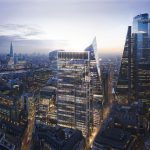We’ve heard a lot about the growth and future of the City with promises of more square footage, more amenities and a greater focus on sustainability and cultural offerings. “More” seems to be the word of the moment.
In today’s fast-paced world, we’ve become increasingly demanding and impatient—thanks, in part, to services like Amazon that set high expectations for wanting more and wanting it fast. So, maybe now it is more important than ever to pause and reassess our approach to the future of workplaces.
Our workplaces have significantly evolved over the decades. From the cubicles of the 1960s, to the open-plan spaces of the 2000s, from the invention of the internet and email to mobile phones that make us contactable anywhere – each era has brought innovations aimed at enhancing productivity.
As we look to the future, our focus is shifting once again towards creating environments that are not only efficient and productive but also inclusive, supportive of diversity and conducive to well-being.
The City of London is uniquely positioned for economic growth due to its location, employment density and transport connectivity. The City is accessible to millions within an hour’s journey, and this is evidenced by the rapid return of employees to the workplace, even on traditionally slow days like Mondays and Fridays. But what we should really be asking is why should people commute?
For seasoned commuters who are accustomed to the daily grind, the commute is routine. We all have our own reasons for enduring the high temperatures of the Central line, more than simply developing a superhuman immune system.
But what about those new to the workforce? The appeal of commuting isn’t immediately obvious or in fact accessible. So, let’s turn the question around: what can we do to attract new professionals, new graduates and new skills and talent to the City both on a local and global level?
Enhancing workplace appeal
London’s reputation as a global talent hub naturally attracts individuals seeking opportunities. Major corporations seek headquarters that offer connectivity, community and character to attract top talent. However, we must not become complacent. To remain competitive, our buildings must work harder.
We need to consider space for networking, easy access to art galleries, theatres, museums, top-tier restaurants and other unique experiences that can’t be replicated at home. We have a rich history and culture that should be celebrated and enjoyed by all.
We need spa-like changing rooms for cyclists who brave London traffic and British weather, we need gyms, boutique fitness classes and wellness amenities to promote a balanced lifestyle and provide time away from the screen for idea creation.
Sustainability is key and will continue to be a priority for the City’s next generation of buildings. Energy-efficient and adaptable systems, such as voice-activated technology for people with reduced mobility and lighting and climate control tailored to active areas of the office should become the norm and will evolve with changing workplace trends, such as the integration of AI.
Promoting inclusivity and accessibility
Ultimately, to attract and retain talent, our offices must be places where people want to be. Employee satisfaction is linked to environments that feel inviting and inspiring, boosting productivity and creativity.
To remain a global city (almost 50% of our workforce is from outside the UK) we need to adopt global design principles. This means creating spaces that are inherently accessible to all, embracing different perspectives and fostering a collaborative environment. This includes considerations for those with disabilities, older professionals and parents with young children. Quiet rooms, prayer rooms and well-being areas are essential to create an inclusive, productive and satisfying workplace.
One of the reasons I personally love London is its diversity, and to continue to be diverse, one size doesn’t fit all – we need to be appropriate with what can be provided but the thought needs to be early on in a project, in the same way we now think of carbon.
Addressing viability and collaboration
Now all of these are ideal world scenarios. The greatest challenge is ensuring the viability of these initiatives. Can we realistically implement these on a building-by-building basis, or do we need a more collaborative approach?
To truly make an impact, we must work together, sharing resources and ideas to create an ecosystem that supports growth, inclusivity and innovation.
The future of office buildings lies in creating spaces that are technologically advanced, sustainable, flexible and accessible to all. By embracing universal design principles, adaptable layouts, inclusive amenities and a focus on well-being, we can ensure that the City remains the number one destination for all.
Not only will it be efficient and productive, but it will also be supportive of a diverse workforce. For more information, please read our NextGen Diversifying Real Estate guidebooks, produced to help individuals and organisations make central London’s real estate sector more inclusive and reflective of our capital’s diverse communities.


